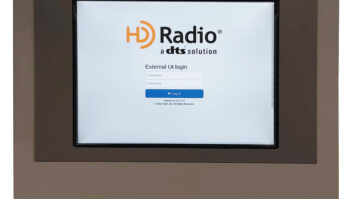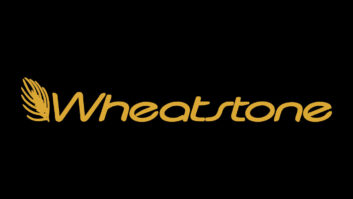Some things can drive an engineer mad. One of the most frustrating is panel lights that burn out.
Our RW colleague Buc Fitch has a fix: LEDs. They have an almost infinite life, ending your bulb replacement routine.
Here are steps to replace incandescent bulbs in Marti discrete STL-10 transmitters.

Fig. 1: Replace incandescent bulbs with LEDs to illuminate the meters. Bonus: The glow serves as a power ‘on’ indicator. Buc writes that the notable annoyance in these units is the relatively fast burn rate of the incandescent bulbs behind the meters. Frustration is compounded because replacing these bulbs is a disruptive exercise at most stations. The units must be powered down and taken out of the rack, the bad bulbs de-soldered and the new soldered back in. You can only do this when you don’t need your STL; and if this is your only link, think 3 a.m.
The STL-10 transmitters lack a pilot lamp to indicate power to the units; Buc’s modification permits the replacement LEDs to also serve as pilot lights, though they do provide good meter illumination, too, as seen in Fig. 1.
To this end, Buc uses a highly focused white light LED from Electronic Goldmine; but any typical T 1-3/4, 5 mm, 20 mA LED will do.

Fig. 2: The trusty old Simpson meter is used to check operating parameters of the LED before installation. Your first step is to measure the optimal LED current, as seen in Fig. 2. This ensures the mod will work before you tear into the equipment. Here, the trusty old Simpson shows 20mA, optimal current for the LED.
There is a benefit to using this T 1-3/4 size LED. It slides smoothly through the hole allotted for the original bulb and solders easily onto the connection posts in the rear. If you want a more vivid color or a more diffused backlight, purchase what you desire in a 20 mA T 1-3/4 5 mm format.
After gaining access inside, you’ll be replacing the old lamp, shown in Fig. 3. Note how the heat has toasted the back of the meter case.
The incandescent bulbs used a pair of two 1/4 watt resistors in series (a 10 ohm and a 3.3 ohm) not only to reduce the supply voltage and lengthen bulb life, but also to niftily jump some solder traces. To limit the current flow through the LED to its optimal 20 mA, the 13.3 ohm resistor combination is replaced with a 270 ohm 1/2 watt (Radio Shack part # 271-1112) in each of the supply paths of the two meter bulbs, as shown in Fig. 4.

Fig. 3: This is the culprit, a burned out incandescent bulb, visible at right. It effectively has roasted the back of the meter. Buc cautions that although the Marti schematic for the meter board indicates that the bulb supply is AC, be aware that there is an upstream diode inline on the power supply board on one of the “AC” legs so you will need to keep the + polarity of the LEDs connected to the post nearest the outside edge of the PCB for proper operation. Completed LED mounting is seen in Fig. 5.
A similar meter light mod works as well in such diverse units as the CBS 400 series Audimax and Volumax and various audio boards such as the venerable Gates Dualux.
The STL-10 does have some more serious difficulties such as the famous “spur problem” and meter switch replacement. If readers express interest in these subject areas, we’ll address them in future Workbench columns.
* * *
We asked you in an earlier column to comment on reliable “air chairs” that work well in the studio.
Mike McClain is with the National Park Service and based in Yellowstone, where they’re using Domore Chairs. These rugged seats carry a five-year warranty; they were purchased about 10 years ago and are still in use 24/7.

Fig. 4: The current limiting resistors must also be changed. Mike says it’s a good chair with only one problem: The arms would sometimes catch under the counter on which the console was sitting.
Domore specializes in “intensive use” seating solutions. Its Web site is www.scopedomore.com.
* * *
As I put together Workbench articles, I’m constantly amazed at the various disciplines of which broadcast engineers must have knowledge. We are one smart breed of engineer!
It’s not just studios and transmitters but things like the best jock chair and maintaining site security. They never taught these things in electronics school or college.

Fig. 5: LEDs are in place and you’re ready to button it up. Engineer Alan Shea at HCJB’s Technology Center likes a security blog, Schneier on Security, compiled by Bruce Schneier.
In a recent discussion, Bruce discussed the “broken windows” theory of crime fighting, which argues that disorderly conditions invite bad behavior and fixing them can help prevent vandalism and crime.
After reading the blog and also seeing our seedy-weedy transmitter site photo, Alan recalled visiting a number of transmitter sites on a mountaintop in upstate New York during a vacation trip.
He noticed a difference in his own attitude when he walked up to a building where grass was trimmed and everything appeared shipshape, compared to a building with grass and bushes growing all over, dirty windows and security/motion lights that didn’t work.
In fact, Alan didn’t explore too close to buildings where everything was cared for because he felt like someone might be watching him.
When he got back to his station, he related this experience. He and his staff decided to engage a person who lived near their transmitter/tower to mow the grass regularly, keep things trimmed and alert the station to anything unusual.
Alan writes, “We never had a problem with any unwanted visitors.”

Fig. 6: Avoid a fine and deter vandals. Trim vegetation from your tower, building and satellite dish. There was another benefit: The clear brush and working security lights made midnight visits to the site a lot easier and safer. Can you imagine needing to get into the ATU in Fig. 6 at night?
Bruce Schneier’s site is www.schneier.com. You’ll find his blog from the selections at the left.
While you’re there, take a look at Password Safe, a free Windows utility designed by Schneier. With all the passwords we have to commit to memory, most people either write them down (defeating security) or just use one, which, if compromised, can give unlimited access to the thief.
With Password Safe, users can keep all their passwords securely encrypted on their computers. A single Safe Combination, just one thing to remember, unlocks them all.
John Bisset has worked as a chief engineer and contract engineer for 39 years. He is international sales manager for Europe and Southern Africa for Nautel, and a past recipient of SBE’s Educator of the Year Award. Reach him at[email protected]. Faxed submissions can be sent to (603) 472-4944.
Submissions for this column are encouraged and qualify for SBE recertification credit.












